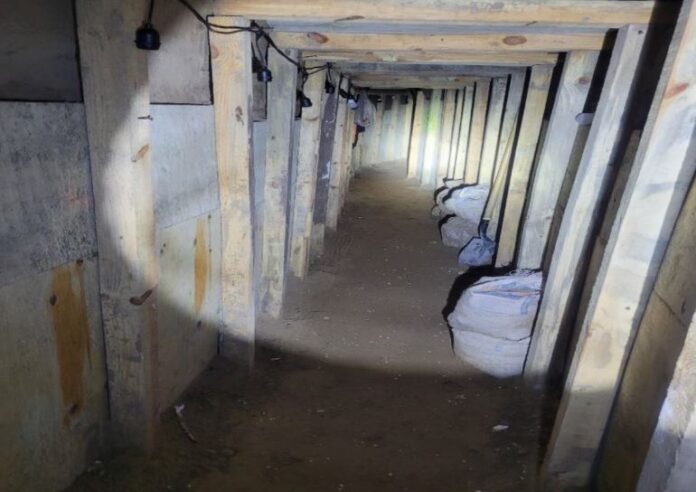In what marks a significant escalation in cross-border smuggling operations, U.S. Border Patrol agents have uncovered a sophisticated tunnel stretching from Ciudad Juárez, Mexico, across the border to El Paso, Texas. This clandestine passage, equipped with electrical lighting and structural reinforcements, serves as a grim testament to the advanced tactics employed by drug cartels in their ongoing battle against border security measures.
The tunnel, unearthed during routine surveillance operations, has features that suggest it was not a mere makeshift pathway but a well-planned and executed project. Its design includes not only the necessary supports to keep the structure stable but also lighting to facilitate movement, indicating that this was likely used for organized smuggling activities, possibly including drugs, weapons, or human trafficking.

The discovery has prompted an immediate and robust response from law enforcement agencies on both sides of the border. U.S. Border Patrol, along with the Texas Department of Public Safety (DPS), and agents from Homeland Security, have converged on the site, initiating a coordinated investigation. The involvement of multiple agencies highlights the seriousness with which this breach is being taken, given the potential for such tunnels to undermine national security.
Investigators are now focused on piecing together the timeline of the tunnel’s construction and usage. Key questions include how long it has been active, who was involved in its creation, and the full extent of its purpose. This intelligence will be crucial in understanding the operational capabilities of the cartels and in formulating more effective countermeasures.
This incident sheds light on the broader narrative of the U.S.-Mexico border crisis, where physical barriers like walls and fences are continuously challenged by subterranean routes. It’s a stark reminder that as above-ground solutions are implemented, cartels adapt by going underground, literally and figuratively. The discovery of this tunnel in El Paso is not merely an event but a symbol of the persistent, evolving nature of border security challenges.
The response from local and federal officials has been one of determination to not only address this specific tunnel but to enhance overall border security strategies. This includes potentially increasing surveillance technology, revising infrastructure, and deepening intelligence cooperation with Mexican authorities to preempt future such endeavors. As this investigation unfolds, it will likely influence policy discussions on border security, smuggling prevention, and the broader fight against organized crime.
Key Points:
- Discovery: U.S. Border Patrol discovered a sophisticated tunnel connecting Ciudad Juárez, Mexico, to El Paso, Texas.
- Tunnel Features: The tunnel is equipped with lights and structural supports, indicating advanced planning and construction for smuggling activities.
- Law Enforcement Response: A massive response from U.S. and Mexican authorities, including Border Patrol, Texas DPS, and Homeland Security, has been initiated.
- Investigation: Authorities are investigating the tunnel’s duration of operation, its purpose, and the parties involved.
- Security Implications: The discovery underscores the adaptability of cartels in circumventing border security measures, highlighting ongoing border security challenges.
- Policy Implications: This event will likely influence future policy decisions regarding border security, surveillance technology, and international cooperation against organized crime.



